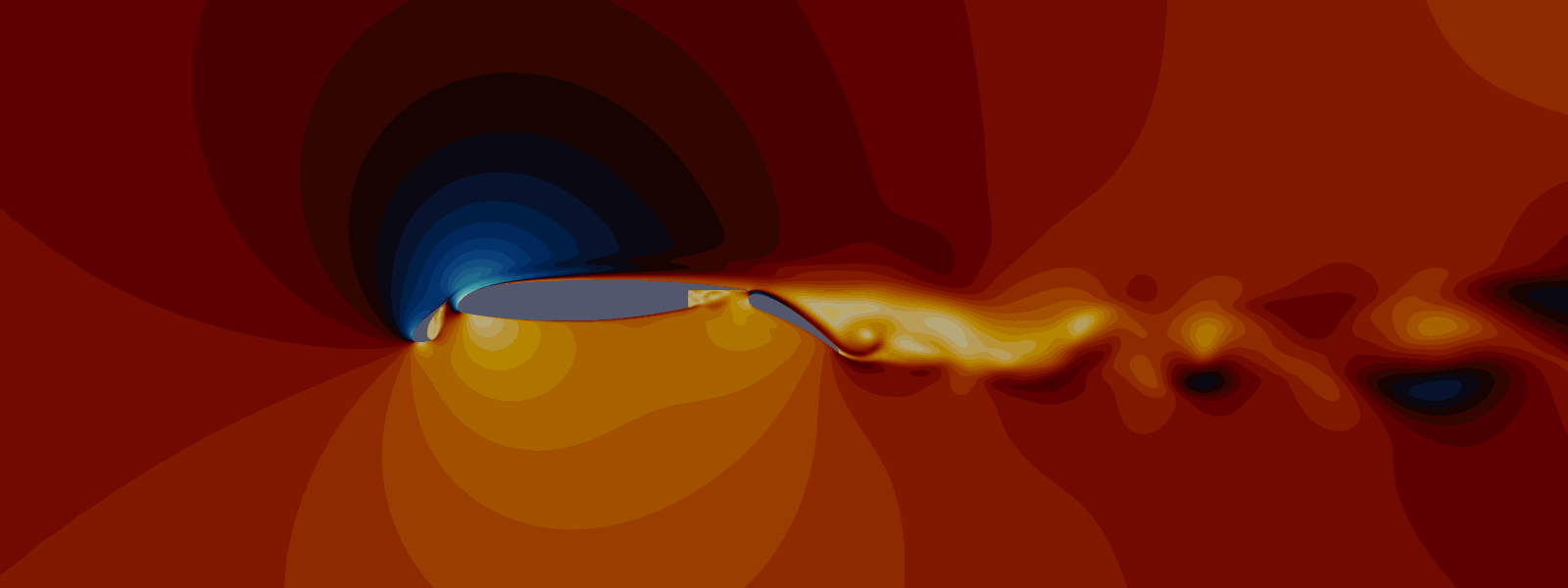Within the area of computational & theorectical aerodynamics, our research focuses on several key methods in which we have a sustained track-record.
High fidelity methods
Research in this area focusses on the development of advanced numerical methods to to discretize and solve the Navier-Stokes and Euler equations. This includes: kinetic-based numerical schemes to enhance the consistency with the physics across various Mach and Knudsen regimes, ph-adaptivity and adapt by re-meshing methods in connection with higher-order discretizations (e.g., Discontinuous Galerkin). This is done in the context of the open-source solver SU2 (https://su2code.github.io).
Reduced basis methods
This area covers the formulation of methods to reduce the computational complexity of CFD studies for multi-point analyses. The approach provides cost-effective (up to the limit of real-time computing) yet accurate (in the order of 10% w.r.t. a CFD analysis) solutions. This includes: Reduced Basis (aka Order) methods based on Principal Components Analysis, machine learning and Galerkin-based projection methods for compressible and complex unsteady flow problems.
Hypersonics and re-entry
The aerodynamics of access-to-space system and trans-atmospheric flight is studied by developing methods that take into consideration aspects like thermal and chemical nonequilibrium and the potential loss of validity of Navier-Stokes approach. This includes studies of Jacobian-free methods for potentially complex systems of equations due to finite-rate chemistry and the introduction of kinetic methods. Research in this area includes also the formulation of low-fidelity methods (e.g., modified Newton theory) for re-entry aerothermodynamics.
Transonic aerodynamics
The methods above contribute to the creation of a highly integrated multi-fidelity platform (from higher-order to low-fidelity methods) for the aerodynamics analysis and design of the next-generation of transonic transport vehicles. This includes: unconventional configurations like blended wings, collaborative fuselages, high aspect ratio wings and the airframe integration of advanced propulsion systems like boundary layer interaction or ultra high by pass ratio concepts.
Research & industrial projects
- Robust- and sustainable-by-design ultra-high aspect ratio wing and airframe (RHEA). H2020 CleanSky2 Joint Undertaking. Partners: TU Braunschweig, Imperial College, DNW wind tunnels, IRT Saint-Exupery
- Multi-disciplinary modelling of the aerothemodynamically-induced fragmentation of re-entering bodies (MIDGARD). European Space Agency. Partners: Von Karman Institute for Fluid Dynamics, Lockheed Martin, Fluid Gravity
- Physics-based Modelling and Simulation of Spaceplanes Nonequilibrium Aerodynamics, UK Space Agency, National Space Technology Program with Lockheed Martin Corporation
- High-fidelity Computational Study of the Aerothermodynamic Performance of Future Sustainable Access-to-Space Systems, EPSRC Impact Accelerator with Orbital Access and Fluid Gravity Engineering
- Multi-physics Analysis and Design of Aerospace Systems, Natural Sciences and Engineering Research Council of Canada with McGill University, Lockheed Martin and Bell Helicopter
Read more about the Intelligent Computational Engineering Laboratory
Key publications
- Maier, W., Needles, J.T., Garbacz, C., Morgado, F., Alonso, J.J., Fossati, M, SU2-NEMO: An Open-Source Framework for High-Mach Nonequilibrium Multi-species Flows, Aerospace 8(7), 2021
- Gimelshein S.F., Wysong I.J., Fangman A.J., Andrienko D.A., Kunova O.V., Kustova E.V., Garbacz C., Fossati M., Hanquist, K., Kinetic and Continuum Modeling of High-Temperature Oxygen and Nitrogen Binary Mixtures, Journal of Thermophysics and Heat transfer, 2021
- Garbacz, C., Maier, T., Alonso, J.J., Scoggins, J.B., Magin, T., Economon, T., Fossati, M., Parametric Study of Nonequilibrium Shock Interference Patterns over a Fuselage-and-Wing Conceptual Vehicle, AIAA Journal, 2021
- Gomes A.C., Maier, T., Alonso, J.J., Scoggins, J.B., Magin, T., Economon, T., Fossati, M., Shock Interactions in Inviscid Air and CO2-N2 Flows in Thermochemical Nonequilibrium, Shock Waves 31(3), 2021
- Pascarella, G., Fossati, M., Model-Based Adaptive MOR Framework for Unsteady Flows Around Lifting Bodies, Model Reduction of Complex Dynamical Systems, International Series of Numerical Mathematics 171, 2021
- Pascarella, G., Kokkinakis, I., Fossati, M., Analysis of Transition for a flow in a channel via Reduced Basis Methods. Fluids, Special Issue: Turbulence and Transitional Modeling of Aerodynamic Flows 4, 2019
- Pascarella, G., Fossati, M., Barrenechea, Adaptive Reduced Basis Methods for the reconstruction of unsteady vortex-dominated flows, Computers and Fluids 190, 2019
- Fossati, M., Mogavero, A., Herrera-Montojo, J., Scoggins, Magin, T., A kinetic BGK edge-based scheme including vibrational and electronic energy modes for High-Mach flows, Computers and Fluids 185, 2019
- Dumas, Isola, Habashi, Baruzzi, Fossati, Finite Element Modeling of Non-equilibrium Fluid-Wall Interaction Beyond the Continuum Regime, Journal of Aircraft 54(6), 2017
- Fossati, M., Evaluation of Aerodynamic Loads via Reduced Order Methodology, AIAA Journal 53(8), 2015
